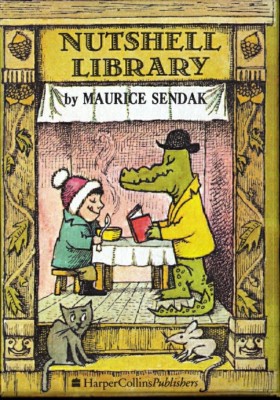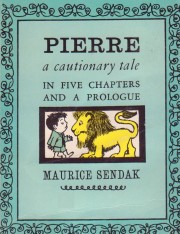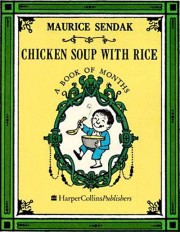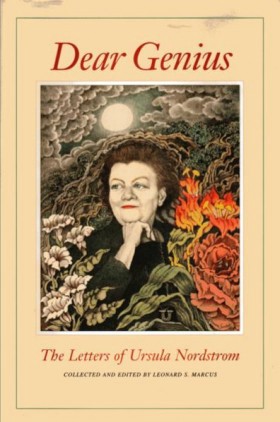Miguel Performs With Lots Of Smoke And A Bigger Light Show Than We're Used To Seeing On Letterman
The young singer Miguel, who we all falling for now, performed his song “Adorn” on Letterman last night. It’s obviously indebted to Marvin Gaye’s “Sexual Healing” and maybe Prince’s “Adore.” But this performance reminded me a lot of an old favorite from the excellent soundtrack to Walter Hill’s ridiculous and wonderful 1984 movie Streets of Fire — Dan Hartman’s “I Can Dream About You.” Also, here’s hoping Miguel’s pompadour erases Bruno Mars from the world’s collective memory starting today.
Maurice Sendak And His Editor Ursula Nordstrom: A Cautionary Tale
by Mallory Ortberg

Today is the 50th anniversary of Maurice Sendak’s The Nutshell Library, which is an excellent collection (anything that features “a cautionary tale” deserves reading) and well worth purchasing if you have or know any children or are feeling especially fragile just now. It contains, among other books, Alligators All Around, notable for being perhaps the greatest book about alligators ever written. Children ought to know more about alligators and be properly frightened of them. When I was a child every night my father would sing to us the same song:
Sooner or later
I’ll be an alligator and I’ll eat all of my children,
every one
Oh, I’m a happy cannibal pappy
I’d love a good infanticidal stew,
Wouldn’t you?
Sooner or later
I’ll be an alligator
Then I’ll eat all of my children
That means you!
It was a very good song for a father to have written, we thought at the time and still think today, and we were often very well behaved as a result. You may sing it to your children if you like.
Maurice Sendak died earlier this year, at 83, but he did write us a lot of terribly nice books so I don’t think it’s right to complain. In addition to writing his own, he illustrated a great many other people’s books, including Else Holmelund Minarik’s Little Bear series. This was almost was not about a little bear at all, as Else’s first American publisher insisted that the bears be replaced with human children. She rightly resisted the change (Luckily for his or her family, the name of this bear-eraser has been lost to time.) But it’s Maurice’s own books which we’re paying tribute to today — how many children learned their months with Chicken Soup With Rice? For those we have partly to thank his incredible longtime editor, Ursula Nordstrom, who was as responsible for the golden age of mid-century children’s literature as any single person could be.
The two met in 1950 while Maurice was working for F.A.O. Schwarz arranging window displays (and really, what would you give to have turned the corner in those days to find yourself staring into the hot eyes of one of his stagings?). She was the director of Harper’s Department of Books for Boys and Girls; he was, in his words, “twenty-two and a half.” Twenty-three years later she would write to him that “it would be nice [to see] on my tombstone…[I] was Mr. Sendak’s editor.”

A partial list of some of the most wonderful things about her: Ursula temporarily owned Pa’s fiddle (of Little House on the Prairie fame), sent by Laura Ingalls Wilder herself. Also, she edited Goodnight Moon, The Runaway Bunny, Charlotte’s Web, Stuart Little, Harriet the Spy, Julie of the Wolves, and Harold and the Purple Crayon (which Will Smith is now developing as a computer-animated film, because sooner or later everything that can happen will happen).
While editing The Long Secret, the sequel to Harriet, which contained the first mention of menstruation in a children’s book, Ursula wrote, “Thank you, Louise Fitzhugh!” in the margins. She helped Marlo Thomas develop Free to Be…You and Me at Shel Silverstein’s request. And she encouraged Maurice to abandon Where the Wild Horses Are, since he could not draw horses, in favor of Wild Things.

Ursula was as committed as Maurice to the idea that it was possible to create works of art for children. In 1972, when she heard a school librarian, offended by the nudity in In the Night Kitchen, had burned a copy, she sent a personal note to the librarian: “We are truly distressed that you think it is not a book for elementary school children. I assume it is the little boy’s nudity which bothers you. But truly, it does not disturb children. … Should not those of us who stand between the creative artist and the child be very careful not to sift our reactions to such books through our own adult prejudices and neuroses?”
In private, Ursula was less circumspect about her feelings toward such censors. “Some mediocre ladies in influential positions are actually embarrassed by an unusual book,” she once wrote to author Meindert DeJong, “and so prefer the old familiar stuff which doesn’t embarrass them and also doesn’t give the child one slight inkling of beauty and reality.”
She should have written a book herself, you might say. She did! The Secret Language, about two girls who develop a special friendship at boarding school, if you’re picking up what I’m putting down, was published in 1960. “Sooner or later everyone has to go away from home for the first time,” it begins; “Sometimes it happens when a person is young. Sometimes it happens when a person is old. But sooner or later it does happen to everyone. It happened to Victoria North when she was eight.”
Like Maurice, Ursula was gay — she spent decades with her partner Mary Griffith, whom she met during her early years at Harper and who was mentioned as a “longtime companion” in her 1988 obituary. The next year she was inducted into the Publishing Hall of Fame.

A decade after she died, editor Leonard Marcus compiled her correspondence in Dear Genius: The Letters of Ursula Nordstrom. The cover, illustrated by Maurice himself, shows Ursula plump and white-faced, smiling and dressed in black. She is surrounded by masses of flowers and sits underneath a full moon. This letter, written to Sendak in 1961 (the year before The Nutshell Library’s publication, incidentally), is a good example of the kind of encouragement Nordstrom provided her writers. The story behind it is that Sendak, illustrating a children’s book by Tolstoy, began to doubt himself and wrote a letter to Nordstrom detailing all his self-doubts. Here is part of what she wrote back:
You reminded me that you are 33. I always think 29, but OK. Anyhow, aren’t the thirties wonderful? And 33 is still young for an artist with your potentialities. I mean, you may not do your deepest, fullest, richest work until you are in your forties. You are growing and getting better all the time. I hope it was good for you to write me the thoughts that came to you. It was very good for me to read what you wrote, and to think about your letter. I’m sorry you have writers cramp as you put it but glad that you’re putting down “pure Sendakian vaguery” (I think you invented that good word). The more you put down the better and I’ll be glad to see anything you want to show me. You referred to your “atoms worth of talent.” You may not be Tolstoy, but Tolstoy wasn’t Sendak, either. You have a vast and beautiful genius. You wrote “It would be wonderful to want to believe in God. The aimlessness of living is too insane.” That is the creative artist — a penalty of the creative artist — wanting to make order out of chaos. The rest of us plain people just accept disorder (if we even recognize it) and get a bang out of our five beautiful senses, if we’re lucky. Well, not making any sense but will send this anyhow.
So today the Nutshell Library is 50. I always think 43, but OK.
Related: The Cost Of Being A Kid In A Classic Adventure Novel
Mallory Ortberg is a writer in the Bay Area. Her work has also appeared on The Hairpin, Slacktory and Ecosalon.
Mike Bloomberg's Affordable Housing Boom Is Astounding!
“The cheapest unit is a 1,128-square-foot two bedroom listed for $1,105,000.” The “Sackett Union” condos, with a view down Court St. into the world’s most awful “German” restaurant, are currently 47% sold.
The Permanent East Village: A Fascist Swamp of Crappy Buildings Now Historic

A central swath of the East Village, formerly known as Little Germany, then known as Little Kraków and Little Dnipropetrovsk, has, astoundingly, succeeded in achieving “historic district” designation. The district stretches down Second Avenue, which is now referred to as “Little Dartmouth Gangsta’s Paradise,” due to the habits of the khaki-clad worthies who clog its congested sidewalks of an evening, alternately issuing mating shrieks and vomit.
A little middle finger of the district extends up to St. Mark’s Place, and its dangling feet hit Second Street. All of First Avenue is not covered, because it is ugly. Congratulations to the hundreds of slumlords who now must receive Commission approval to make any alterations to their buildings, not that they were going to, most of which should be torn down anyway. (Here are photos of some that should be preserved.) Also congratulations to Philip Glass, whose home, it appears, makes up a tiny corner of the district.
To be fair, the neighborhood has been all downhill since 1834, when the City drained a swamp and imposed Tompkins Square Park on the people so as to create an public promenade to enforce socially acceptable behavior, except during the Mexican-American War (spoiler: we lost), when the park was a military staging ground, and then after, when the park became a meeting place for angry young unwashed people to march on Wall Street (the mid-1850s), until it became a Civil War encampment, and then until it again became a gathering place for dirty people to march on Wall Street. At last, several decades ago, “master builder” and white supremacist Robert Moses descended and imposed a new order on the park, so it could better serve as a fascist panopticon, until all the cool people died and the FBI wrote the musical Rent about it.
Sketchy Guy Who Made Anti-Islam YouTube Looks About How You'd Expect
The serial grifter behind the notorious anti-Islam YouTube video The Innocence of Muslims goes to court today in Los Angeles. Mark Basseley Youssef, which is kind of a Muslim-sounding name, is accused of violating his parole for something or other. (Inciting global riots that led to many deaths, including the death of a brave U.S. ambassador in Libya? No, not for that.) Anyway, you will be surprised not at all to learn that this sketchy character looks exactly like you’d expect! (A serious role for Danny DeVito, perhaps, to constructively use the anger from his marriage troubles?) The same courtroom artist also did some amazing portraits of Courtney Love and Paris Hilton.
Introducing The Cantina Bell Menu
by Sam Pattillo

Everyone has a routine. People wake up, maybe hit the gym, and then go to work. Day-in and day-out often the most difficult choice of routine is: What’s the right move for lunch? We live in a world where the diversity of lunch options can be paralyzing and limited at the same time!
Balance is the key to great work-week lunches. You want something above the snack classification, but something that doesn’t limit afternoon production via food coma. Price is also a determining factor. Lunch needs to be a cost-effective meal. Dinner is where the big bucks are spent.
And this brings us to my most recent stop on the daily lunch time journey: the Cantina Bell menu from Taco Bell. Having become aware that Taco Bell has this new lunch option, I went off to try it at the Union Square location in NYC. Background: T-bell (as I like to call it) has partnered with Chef Lorena Garcia to bring its patrons some new dishes — featuring new and different ingredients. I like to imagine Chef Garcia literally putting her boots to the ground to hand-pick the ingredients that end up in the recipes bearing her name.
As the journey continued and I was about to make my order, I saw that the new menu includes the classic nouveau-Mex food decision: bowl or burrito to house the ingredients? And the ingredients? Well, you can construct a burrito or bowl that can include any or all of the following: black beans, cilantro rice, chicken, guacamole, fire-roasted corn salsa, cilantro dressing, romaine lettuce and pico de gallo. Obviously veggie options are also available.
I normally love a good side dish with my lunch; it’s often my favorite part of the lunchtime meal. I like the chips more than sandwich, fries more than the burger and pita more than the salad. But there are no sides with the Cantina Bowl, and that’s the beauty of it. The Cantina Bowl is a meal that comes with sides already included. There’s absolutely no need to order additional sides. Along with the main event (in my case, chicken) automatically comes the traditional sides of guacamole, rice and beans. SIDES INCLUDED, NO EXTRA COST. And a quick promotion of the bossest of all sides: guacamole is the stereo system of the lunch time party. It keeps the metaphorical flavor party going. Don’t lunch without it.
Be sure to hit up the local Taco Bell if you like your meals with sides included.
This post is sponsored by Taco Bell. Inviting you to try the bold new Cantina Bowl.
Well, Fuck You, Amygdala
“If the mere thought of fingernails scraping along a blackboard makes you cringe, blame your amygdala. Scientists have discovered that this primitive almond-shaped brain region is behind our aversion to high-pitched sounds.”
How Many People Do You Think Jack Welch Knows Who Have A Hard Time Finding Work?
“As I said that same evening in an interview on CNN, if I could write that tweet again, I would have added a few question marks at the end, as with my earlier tweet, to make it clear I was raising a question.”
— Well, at least Jack Welch has a future as a blogger.
Thank You, Monk
The incomparable Thelonious Sphere Monk would have been 95 years old today, and that, at least to me, is something worth celebrating. The man was a genius.
Is Barack Obama Still America's Cool Uncle?

In less than a month, thank god, Election Day will be here and then gone. There are more debates, and more October Surprises, and many more tens of millions of dollars to be spent on horrifying television commercials, and then we can finally go back to “fantasy football” or whatever people do with their time.
Despite being too conservative and too much of a warmonger for many liberals’ taste, Barack Obama will most likely win a second term because who else are we going to vote for, that nice lady who shares our views exactly, on that Facebook poll? As far as presidents go, with their whole Commander in Chief and “license to kill” routine, Obama is not terrible.
The more important question, for the Internet, is whether or not Barack Obama is still “America’s Cool Uncle” — the guy who listens to old-school soul and sneaks Marlboros on the White House roof and gets Bob Dylan and Stevie Wonder to play parties in the Executive Lounge and has a super-hot wife. Is Obama still this guy, or did he sell out so much that now he’s America’s Jerk Uncle Who Nobody Even Wants To Invite Over For Thanksgiving?
My comrade Alex Pareene distilled Obama’s personality down to America’s Cool Uncle back in 2008, when the idea of an even vaguely cool president was too nutty for certain people to process. “Respect knuckles” didn’t make Obama a terrorist, much as Fox News anchors loved the idea that scary black people had habits too alien for Mainstream America. White singers in giant cowboy hats routinely gave each other “terrorist fist jabs” on the CMA Awards, and they weren’t sending suicide bombers to our nation’s white neighborhoods.
Still, having a couple of million-selling hip hop tracks on his iPod didn’t make Obama much different than the with-it mid-40s guys who loosen their ties and put in their earbuds as soon as they’re released from the Wall Street highrises for the day. And much like the entire generation of college-educated 1980s kids, Barry partied and had a hard time deciding between a life of conventional success and more noble pursuits. He typed “business intelligence” for a New York firm and romanticized the broken city when it wasn’t grossing him out. Then off to the Chicago housing projects, where he tried to be a do-gooder and got so frustrated that he took the “easy out” available only to the very clever and very wealthy: Harvard Law School.
It’s not like Barack Obama was Keith Richards. He just wasn’t a deeply corrupt and culturally clueless lifelong politician confused by every aspect of the modern world (beyond corruption). Remember that it was controversial to allow President Obama the use of a Blackberry and some occasional glances at the Internet via his secretary’s computer. Presidents weren’t supposed to have any idea about that stuff.
Four years later, even the more forgiving “cool uncle” is questionable. For one thing, cool people don’t use robot death drones to kill entire families celebrating weddings on the other side of the world. (It is only cool to kill super villains with your own pistol and/or hands, like in those James Bond and Jack Ryan movies.) Cool people also don’t constantly give up and let the Republicans have whatever they want. And don’t forget all those pictures of Obama in Costco polo shirts and mom jeans.
Decent people, however, don’t act so differently than Barack Obama. They are kind to their children, good to their spouses, and they mean well even when they fall short. A decent president of the United States also has a heavier moral burden than, say, a blogger. This nation, through its military and corporate tentacles, is responsible for a lot of actual evil in the world that’s excused for the usual reasons of national security, control of resources and plain old profit. Lots of people and movements around the globe have legitimate gripes and will never get a fair chance to challenge U.S. power, while the remaining strongmen and dictators have plenty of reason to sic the disillusioned on symbols of American hegemony. In our age of spectacle, it takes a 9/11 or shooting up a theater dressed as The Joker to get any attention from a busy planet. The least cool part of being president must be deciding if it’s best to drop a bomb on somebody’s suspected lair to prevent a whole lot of other somebodies being killed. And yet, there are cool and clever uncles who spent their careers working on widgets for defense satellites, or creating pills that gave old men boners. “Cool Uncle” is a lower bar than plain cool.
Barack Obama’s first term as president has been an extremely mixed bag. People (like me) who finally fell for his whole thing, including the HOPE posters created by a street artist and not by the actual campaign, were understandably let down when President Obama didn’t arrive at the White House with Jedi mind tricks and a working lightsaber. That’s because the coolest thing about Barack Obama was never actually Barack Obama — it was his story, the story of a kid not unlike so many American kids growing up in the 1970s and 80s, with weird family combinations and missing-in-action dads and bad television and grandparents who picked up the slack and a mom who refused to settle because she couldn’t keep still. In a country with an entrenched elite and disgraceful income disparity, a smart black kid from a broken home actually got an Ivy League education and became president of the United States. It’s the kind of story Republicans love to tell but hate to ever see happen. And it is what makes dorky golfer dad Barack Obama the coolest uncle in American History.
(Plus, Mitt Romney is such a tool, he makes Harry Reid seem like Miles Davis.)
